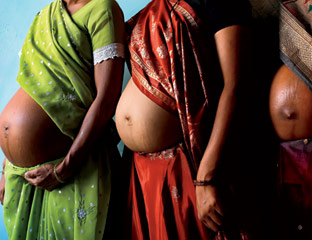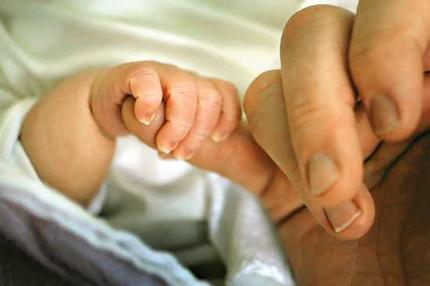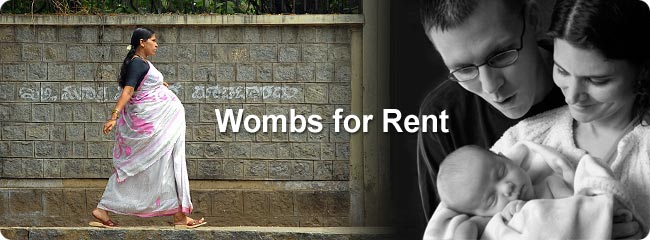 |
||||
|
Wombs for Rent
Is paying the poor to have children wrong when both sides reap such benefits?
Rent a Womb for $2500Smita Pandya, is expecting her third child. Unlike the other two, she is being paid to carry this one. "Why not, if it helps me give my own children a better future?" asked the housewife. Navina Patel, 26, her two sisters and her sister-in-law have all taken to bearing children as a means to enhance their living standards. "My mother-in-law suggested it to me. We needed to buy a good house," said Navina. Three months ago, Navina’s sister-in-law became a surrogate mother of twins. "We now have a good house to live in," she adds. Shilpa, 32, one of her sisters said: "Only my husband knows about it. I feel it is noble as it will bring happiness into a couple’s life."
The women are part of womb renting industry that has spawned in the rural hinterland of Anand in India’s state of Gujarat. Primarily catering to childless Indian couples living in Canada, Britain, Australia and the United States, the professional surrogates get paid between one and two lakh rupees (about C$2,500 and C$5,000) to improve their poor and landless lives. Their champion is gynecologist Dr Nayna Patel, who has been practicing In-Vitro Fertilisation (IVF) for seven years now in her hamlet of hope. The gynecologist who has been tending to numerous "clients" at her hospital in Anand told the Press Trust of India, "women preferring to become surrogate mothers are briefed right from the start that they will have to hand over the child to the childless couple soon after the delivery and are repeatedly told this whenever examined during pregnancy." "This is for the benefit of surrogate women so that they do not nurse any attachment for the child after the birth." she said. Dr. Patel, director of the Akanksha Infertility Clinic knows what she is talking about. She was a key player in the so called "grandmother case", where a woman delivered her daughter’s twins in 2004. Last month she paraded about a dozen professional surrogates from Anand in front of Indian media as she pushed for acceptance for professional surrogacy. Wearing surgical masks and baby blue and pink aprons to hide their identities, the women – all married with children of their own spoke candidly to the media of being mothers for hire.
"I came to know about commercial surrogacy through another surrogate mother. Initially, I had a tough time convincing my husband to shift out of the joint family. However, he agreed as the fee was quite an incentive," said Dikshita Shah, 30, a working mother of two children. The IVF technique involves the egg of the biological mother being fertilised with sperms of the father in a test tube. The embryo is then transferred into the uterus of the surrogate mother. Another lucrative source of income for the women in Anand is egg donations. ‘‘We earn anywhere up to five thousand rupees (about C$130) in 20 days’ time. Where will we earn money so quickly without doing anything immoral,’’ said a woman identified as Geeta. As news spreads and egg donors get introduced by their neighbours and relatives, hesitation about surrogacy is dissipating, reported Indian media. In fact, Geeta is willing to reverse a family planning operation to chance an earning as a surrogate mother. "We have no land; my husband is a rickshaw driver. We all want a decent life. Instead of doing something bad, here we have the satisfaction of giving someone happiness too,’’ said an egg donor, who called herself Rita. "Women without uterus and underdeveloped uterus or medical conditions are forced to go for surrogacy," says Dr Mona Bhatt, a gynecologist in Vadodara.
Doctors say 70 percent of the clients are Non-Resident Indians (NRIs) who find their efforts to get a child cheaper in India. "Most NRIs prefer surrogate mothers from India as it is easier to find one. An agency abroad may charge about US$30,000 and the surrogate mother is given another US$15,000. Moreover the surrogate also enjoys certain rights over the baby," said Dr Patel. "In India, the couple just needs to clear the medical bills and pay about Rs 1 lakh or more to the surrogate mother." The surrogate mother and egg donation industry is also catching on in other parts of India. The Pune Fertility Centre in Shivajinagar recently announced a ‘surrogacy programme’ and invited ‘women in the 25-30 years age group’ to enroll as members. ‘‘Monetary benefits are playing a key role in attracting women to act as surrogate mothers. The rent-a-womb contract for the surrogate mother can be as high as 10 lakh (about C$25,000),’’ Pune Fertility Centre lab director Shehbaaz Daruwala, was quoted as saying.
Daruwala said the demand for ‘‘eggs’’ were primarily from women with a genetic problem or with those whose ovaries don’t have eggs or from women who suffer from premature ovarian failure. Chief IVF consultant and endoscopist at Ruby Hall Clinic Sunita Tandulwadkar said they had been receiving several queries. ‘‘It is legal in India,’’ she said. While wombs for rent in India may be legal, in Canada it is a different story. The Assisted Human Reproduction (AHR) Act states that no payment can be made to a sperm or egg donor for their donation nor can payment be given to a woman providing surrogacy services. Section 6 of the AHR Act prohibits anyone from paying a person to act as a surrogate. It also prohibits anyone from receiving payment for arranging, offering to arrange, or advertising to arrange the services of a surrogate. Fines under the Act range from C$250,000 to C$500,000. An official with British Columbia’s Adoption Agency told The Asian Pacific Post that Canada and India are among the signatory-countries of the Hague Convention on Protection of Children and Cooperation in respect of Inter-country Adoption which aims to stops trafficking of children and illegal adoptions. She, however, said that surrogacy is not specifically covered by the convention.
The official noted that India allows only people of Indian origin to adopt children from India to ensure that these adoptive children are going to families of the same cultural background. Kathleen Walker, a Vancouver-based family lawyer said surrogate motherhood is "technically a no-no" in Canada. "You can’t pay for anything and if I understand it, not even for medical expenses. It’s a very tough law. Over my 15 years of practice, I’ve never come across surrogate mothering." Walker said if all the activities related to the contract are done in India, the general rule in law would say that Canada has no jurisdiction. "But if negotiations are initiated or done from Canada, the law will come into play," she said.
|
||||
|
|
||||
Is paying the poor to have children morally wrong?Pushpa Pandye still sometimes cries when she thinks of the baby. She didn't eat for a month after she gave him up, a little boy weighing 5 lb. 4 oz. who came into the world last April in a utilitarian delivery room at the Kaival Maternity Home & Surgical Hospital in Anand, India. "He was so cute," she says ruefully. After she gave birth, she nursed the infant in her room at Kaival for two weeks. Her husband and two children met him; her eight-year-old still remembers the baby who lived in her mother's tummy for safekeeping. And then Pandye handed him over to his rightful owners and genetic parents, a couple from the Indian city of Bangalore, some 1,400 km away.
Another nine or 10 months from now, assuming the pregnancy "takes," she plans to go through the entire exercise again, this time for an Indian immigrant couple settled in the U.S. Already she dreads the delivery date. But her stint as a paid surrogate has given her an opportunity she couldn't otherwise have dreamed of: the chance to escape the lower-middle-class ghetto in what remains one of the most rigid class-bound democracies in the world. For her last pregnancy, Pandye was paid 150,000 rupees, or $3,900 -- a sum that would take her years to earn in her job as a clerk at an incense store or with her occasional work as a government security guard. She used the money to purchase a two-bedroom flat. The money from the next pregnancy will allow her to send her kids to a better school -- where they can learn English and work with computers -- and then to college. Her heart's desire is that her daughter will become a doctor, or else a pilot. Pandye is a bright, high-spirited 28-year old from this town in the state of Gujarat, in the western tip of India. She possesses only a high school education -- an abiding regret, since her ambition was to become a teacher -- but her geographic location has given her an unusual and spectacularly lucrative career option unthinkable in another time: she's part of a cottage industry of Indian surrogate mothers who have given hope to dozens of infertile couples all over the world, and new life to this dusty town. Anand (population: 110,000) is an unlikely destination for a medical tourism boom. About an hour-and-a-half from the nearest airport(in Ahmedabad, an hour or so by air from Delhi or Mumbai), it's a remote, Podunk town by Indian standards, the kind of place where mailing addresses include notes like "behind Surabhi Regency." For years the area's sole claim to fame was that it's the headquarters of Amul, the billion-dollar brand of the Gujarat-based co-op that supplies milk and butter to Indian families and was for a long time the nation's chief purveyor of cheese. These days husbandry of a different sort draws visitors here, and it takes place just a kilometre or so away from the Amul complex, in the salmon-coloured stucco building where Pandye gave birth. The woman who delivered the baby and presides over the hospital is an obstetrics and infertility specialist named Dr. Nayana Patel. Nayana-ben, as she's known in this region(ben means sister, a term of respect), vaulted to fame and into the reproductive tourism business a few years ago, after she facilitated a rather unorthodox surrogacy arrangement. She was contacted by a U.K.-based couple on behalf of their son and daughter-in-law, Aakash and Lata Nagla, who were desperate for a child. Infertility threatened to break up the marriage, and the parents begged Dr. Patel to do something. She did. The problem was with Lata's uterus -- she didn't have one. But her eggs and ovaries were perfectly functional. So Dr. Patel removed some eggs, fertilized them in a petri dish with the husband's sperm, and transplanted the resulting embryo into another woman's womb: Lata's mother's. In February 2004, 44-year-old Vidhya Valand gave birth to her grandchildren, a twin boy and girl, to great media hoopla, and some social outrage. Within months, Dr. Patel had overseen her first commercial surrogate birth, and had inquiries for others. Grandmothers-in-waiting are not always a reliable option, and Dr. Patel began seeking out paid surrogates. She has since arranged more than 70 surrogates for couples from India and from as far away as Japan, Finland, Germany, the U.S. and Canada. She has created a gainful if not exactly desirable career niche for dozens of impoverished women in neighbouring villages and towns and indeed across India. And she has helped launch a national boom estimated at $200 million around a process that raises a tangle of ethical questions: is it moral to pay the world's poor to have our children? Have we opened the door to shady practitioners who are exploiting women? Does surrogacy, as critics suggest, turn the parent-child relationship into a matter of property rights? In the three years since Vidhya Valand carried her daughter's twins, the number of IVF clinics in India has doubled. There are now an estimated 600; of these, 200 are thought to offer surrogacy(numbers are hard to track because clinics don't have to be accredited). Nonetheless, the phenomenon dubbed "rent-a-womb" or "outsourcing pregnancy" is so controversial many of the women who volunteer for it don't tell their families or friends. Of course, Dr. Patel has a catchphrase of her own, a positive spin on the arrangement. "This is the globalization of reproduction," she told a roomful of Indian reporters at a February press conference to mark her latest hand-off: a Korean-American baby, born in Anand to a surrogate from Kolkata. One doesn't become an international medical superstar without some media savvy. Outsourcing surrogacy perhaps marks the newest wave of offshoring, a model that goes further than the manufacturing wave kicked off in the 1980s or the services wave of the past decade, to trade in that most basic building block of the labour market: the human body. In Madras and Manila, the desperate poor sell their kidneys for not much more than $1,000. In India, China and Brazil, the underprivileged volunteer by the thousands as guinea pigs for big Western pharmaceutical companies; the consulting firm McKinsey expects the clinical-trials business in India alone to top US$1.5 billion by 2010. Paid egg donation is a budding business, too -- a successful sideline that's helped Kaival Hospital become a one-stop infertility centre for Indian emigrés as well as foreigners of every race and ethnicity. It's only bound to grow; a recent Washington Post article revealed that Asian eggs -- Indian, Chinese and so on -- are in very short supply in North America. Supplying wombs for pregnancy just seems the next natural leap. None of this, of course, was on Razia Khan's mind when she spotted a story about Dr. Nayana Patel in an Indian magazine at the library. An Indian immigrant settled in a western Canadian city, Razia just wanted a baby.(Her name and a few identifying details have been changed at her request.)She had a hysterectomy a few years ago, a medical necessity that did not cause great emotional anguish at the time. She and her husband, Arman, already had a young son. They hadn't planned on having more children. Then the urge for another baby hit, and it was visceral. They considered adopting, but a few phone calls to domestic adoption agencies told them it wouldn't be easy. International adoption seemed both expensive and complicated. That's when they read about the work being done by Dr. Patel, not far from Mumbai, where their families still live.
The Khans aren't the type to dither. They moved to Canada almost on a whim 10 years ago after Arman, who works in finance, saw a Canadian government ad in a magazine, inviting skilled professionals to immigrate. The article about Dr. Patel had a similarly speedy effect. "Magazines play a role in our big decisions," laughs Razia, a young woman with a pleasantly unhurried manner and an easy smile. They called the clinic the next day. A month later, they finally got the doctor. Her response was lukewarm. Dr. Patel, exercising the kind of judgment and moral discrimination expected of any governing body with a large supply of needy parties and a limited supply of resources, pointed out they were lucky enough to have one child; there were others who were worse off. But they didn't give up, and eventually she relented. So the Khans, observant Muslims, found themselves on a plane to Mumbai, and then en route to Anand to meet Dr. Patel as well as the Hindu woman who was going to carry their baby. Anyone asking around Anand for directions to Kaival Hospital or the Akanksha Fertility Clinic meets with blank stares. But mention Nayana Patel and doors open. The hospital looks like any small-town medical clinic in the developing world. There is a dusty courtyard outside, shaded with mature neem and peepal trees and populated on this day with a couple of Tata Indica cars and their drivers, as well as a stray dog or two. A sign requests visitors to remove their footwear before entering the hospital(a regional practice, not a medical thing). So, just outside the doorway sit several haphazard lines of shoes; beside them is a long, three-tiered shoe rack, mostly empty. It is a clinic employee's responsibility to stop by periodically and transfer the footwear from the floor to the rack. Labour in India is cheap; one can pay people for the most trivial of tasks, or the most profound. Inside, couples or pairs of women file into the waiting room. A few, like the Khans, are clearly from outside India. Not all are here to explore surrogacy; some have come for a standard gynecological checkup, or about fertility issues or to find an egg donor. Notwithstanding the execrable smell of phenyl(the bionic-strength cleaner of choice in Indian hospitals, offices and, sadly, many homes), this facility is cutting-edge. It's equipped with a state-of-the-art IVF system that allows everything from 4D ultrasounds to pre-implantation genetic testing; a windowless lab, just off the waiting room, is equipped with an Olympus inverted microscope with micromanipulator, a CO2; incubator, and an assisted laser-hatching machine, where, on this day, 10 embryos wait to be moved to the embryo freezer. But Dr. Patel's real arsenal is on the third floor, which is taken over by women in different stages of pregnancy or pre-pregnancy, all here so the clinic can monitor their condition. The six or seven rooms, down a blue corridor, are sparsely finished with a few metal cots, maybe a picture on the wall, like the baby poster in one room bearing the caption "Oh no!" There is a languor about the place; even at three in the afternoon the dozen or so women here are mostly dressed in nightgowns -- colourful full-length numbers with printed floral patterns and lace trims. Other than the clothes they wear they have few personal effects, just a tote bag or two. Later in the evening, six or seven of the women, most of them in their twenties, cluster in one room, still in their nightgowns, sprawled on the cots. If there is something unsettling about Westerners outsourcing a biological process to a less developed country, it's not apparent here. A peculiarly female energy pervades the place. Most of the women seem happy to never leave the premises; meals are catered, kids are in the care of husbands or parents, and jobs are on hold. They will get better care for these pregnancies than they had for their own; many simply gave birth at home, with no doctor at all. For some, it's the first time in their lives they haven't had to work. They chat and laugh; it's an odd sort of slumber party. Occasionally a husband or child comes by -- they all have kids; Dr. Patel won't admit anybody who hasn't proven her fertility. Surrogates and their husbands have to sign contracts promising to hand over the baby after delivery, but kids of their own are a kind of psychological insurance. While many surrogates also donate eggs, they're not allowed to donate for the couples for whom they are gestational surrogates. Every woman in the surrogate wing has a story. Anita, a middle-class professional who works at a bank, became a surrogate for the Korean-Americans, Thomas and Karen Kim, because her eight-year-old son had a heart condition and needed an expensive operation. Daksa, who delivered in April, came with a friend who was donating eggs, which pays 5,000 rupees, or $150, per visit. She heard about surrogacy and decided to volunteer. A plain-spoken 26-year-old who at eight months hardly looks pregnant, Daksa works in the fields, earning 12 or 13 rupees a day. Home is a leaky hut in a village nearby. Universal public education doesn't exist in India, and her children, like many kids from impoverished families, would simply be put to work early were it not for their mother's well-paying contract. Her fee will buy a proper home and school fees. "This is not wrong or harmful work -- it's good, pious work," she insists, invoking the Indian accounting principle of karmic debits and credits. But even her parents don't know this isn't her baby. She's been living at the clinic for a few months and will return only after the delivery. "I'll have to invent some excuse," she shrugs. Many women just say they miscarried late in the pregnancy, or that the baby was born but then died. Surrogacy seems to present a special opportunity to single mothers. Rekha, who is 32, left an abusive marriage.(Rekha is a pseudonym, as are Anita and Daksa.)Her husband kept the kids because she couldn't afford them. She saw an article about Dr. Patel and decided to come here: she is having a baby and giving it up so she can get her own kids back. Childbirth isn't easy for her; she was in labour for five days for each of her kids. She will rent an apartment in Anand during her pregnancy; like all clients, the American couple she is carrying for will pay living expenses and rent -- a monthly stipend of around $60. The couple were moved by her situation, she says. "They said to me, 'You are still young. Why don't you let the kids go and get married again and have more kids?' " she recalls. "But what guarantee do I have that my second husband will be good? I'll be happier just having my two children and not marrying again. Men are not important." Another single mother, Deepali, who sells car insurance, divorced her husband after he tried to poison her. She lives with her parents now. She got pregnant for a South African couple so she can afford her own home, and for the sake of her two kids. Sometimes things go wrong; it took Deepali four tries to get pregnant; one successful attempt ended after she contracted chikungunya, a viral fever. She miscarried within the first trimester, which meant she wasn't even paid the first instalment of $660. This is one of the perils of surrogacy; some women leave jobs, wait around for testing, and get implanted -- all for little or nothing if they don't get pregnant or carry a baby to term. Still, she says, "surrogacy is not harder than any other option. The hard work is only for nine months, and then I'm free." She never wants to remarry. "It's only about me, my kids and my future." She's a lively, tough-minded young woman; if she knew the word, she'd call herself a feminist. Hearing the stories, it's hard not to be thankful the women have the financial option of surrogacy -- and simultaneously outraged by an economic model that exploits such raw need. But Dr. Patel is quick to point out -- and the surrogates echo this -- that there is sheer, desperate need on the other side, too. "There are so many couples in this position," she says. "We used to say, 'find your own surrogates or go for adoption.' Then I really came to know the plight of such couples." In a culture that views parenthood as both birthright and social duty, there is great empathy and a moral imperative, beyond the economic one, to help those who can't attain it. India has not been at the vanguard of new reproductive technologies in recent memory. The world's first test-tube baby, Louise Brown, was born in 1978; its second, a little girl named Kanupriya, was born just over a month later, in Kolkata. But the procedure was controversial and the government clamped down; there wasn't another IVF birth in the country until 1986. Even infertility, Dr. Patel says, was not viewed as a very promising specialization until recently; colleagues warned her there wasn't much of a future in it. Now reproductive tourism alone is estimated to be a US$440-million business. Clinics offering IVF, egg donation and surrogacy are mushrooming in Delhi, in Mumbai, in small towns like Indore and remote tribal provinces like Assam. Dr. Patel didn't bring surrogacy to India -- that title goes to a Chennai-based doctor, Dr. Kamala Selvaraj, who still sees patients for surrogacy. Just a few years ago, Dr. Selvaraj recalls, there was a slum across from the hospital where she practises. It has disappeared. The huts are gone, replaced by apartments and a couple of hotels, mostly catering to reproductive tourists. Similar effects of the boom are no doubt seen elsewhere. Partly, the surge in surrogacy is a reflection of more permissive laws. In Canada, paid surrogacy is illegal. Intended parents still find ways to compensate surrogates, for "expenses," or with "gifts" of cash. The bigger hurdle, for most, is finding a willing surrogate -- and then paying the fee. The Indian option eliminates all three obstacles. Until recently there was a legal vacuum, allowing the sector to emerge; new guidelines for assisted reproductive technologies are now before a specially convened committee. If approved, they will go on to Parliament and likely become law, making surrogacy officially legal. As for surrogates, there is a wide pool of candidates. And the cost savings are substantial. Where those pursuing surrogacy in the U.S. or Canada can spend upwards of $20,000 -- the Korean-American couple encountered surrogate fees alone of US$50,000 at home -- Indian surrogacy can be accomplished for $5,000 to $10,000. As Pushpa Pandye puts it, laughing mischievously, "Here it's like a big sale. Think of it as a 50 per cent discount." It can be more like 80 or 90 per cent. Dr. Patel's fees to surrogates are at the high end. Dr. Selvaraj's surrogates are paid closer to $2,500 plus expenses. Some clinics may be even cheaper. But Dr. Aniruddha Malpani, a leading IVF specialist in Mumbai, has a caveat for anyone shopping in this bargain-friendly market. Laws in the home countries of intended parents should be considered, he warns. And the guidelines are not yet binding; clinics won't be accredited for at least another two years. For now, couples have little recourse should things go wrong. Dr. Kamini Rao, who was on the committee that drafted the guidelines, has heard of such cases. One couple took their surrogate to court after she refused to hand over the baby.(The woman later changed her mind.)There are hucksters, she says, who advertise for surrogates in women's magazines and exploit them. Under the new law, doctors won't involve themselves in negotiations; agreements must be drawn up by a lawyer or with an agency -- meaning more fees. The thinking, says Dr. Rao, is that women are less liable to be swayed by a lawyer than a clinician. Dr. Patel's renown has likely spurred imitators. Her success, though, doesn't solely lie in the monetary advantage, or even in the high quality of medical care. It comes down to one fact: she finds the surrogates. Many clinics stay out of the recruitment business for legal and ethical reasons. Dr. Rao, who is president of the Indian Society of Assisted Reproduction, handles surrogacy cases but insists that couples make their own deals with surrogates. Dr. Patel, on the other hand, also citing ethical reasons, does the recruiting. Few agencies or clinics offering surrogacy services have her supply of willing wombs.
Dr. Patel follows a rule book of her own. She's emphatic that surrogacy is for cases where the biological mother cannot carry a baby to term -- not a lifestyle choice. She will not accept as a surrogate a woman who has already had two C-section births; she doesn't think it's safe. "If a patient insists and does it, there's nothing you can do. It's her choice, her body. But here she is doing it for someone else. I cannot allow her to risk her life," she says. She refuses to deal with gay or lesbian couples, though she has had inquiries from all over the world. "I am not comfortable with it," she says genially. And her pairing of surrogates with clients is an invisible process that simply yields a long-distance call from Anand -- if you're lucky. Not only does she recruit the surrogate, she checks her medical history, sexual health, blood count and type, and so on. She screens both parties for conditions like AIDS. She handles the legal paperwork, monitors the surrogate during pregnancy, updates the client, delivers the baby, and sticks around for the handover. In the offshore baby industry, she is CEO, CFO, plant manager, HR consultant and more -- all without taking an additional fee. She gets paid only for the embryo transfer and the delivery; the rest comes from a sense of duty to both parties. "It's a very, very emotional issue," says Dr. Patel. "It should be handled with real care." The approach is distinctly non-Western, and equally anomalous in her own country. She persuades reluctant husbands of the merits of their wives becoming surrogates. She helps the women who relocate to Anand for their pregnancies find apartments. She can rhyme off -- and does, with a startling disregard for doctor-patient confidentiality -- the personal circumstances of her clients: who resorted to surrogacy because her uterus "had shrunk to the size of a small bud"; which surrogate's husband is a boozer who showed up drunk to a bank appointment and got a stern talking-to from her; what so-and-so did with her first instalment payment of 25,000 rupees. When an embryo transfer doesn't work, she says, she doesn't even feel like eating. "You cry for one patient, I tell them. I have to cry for so many patients." Her relationship with both sides borders on filial. At the press conference, she coached Karen and Thomas Kim, who were too emotionally spent to deliver sound bites. When they refused to reveal how much they paid, she simply did it herself(US$10,000). With the surrogates, she gets even more involved. The middle class in India, in the spirit of noblesse oblige, has long intervened heavily in the affairs of the help. Dr. Patel seems motivated by an even deeper sense of responsibility, sometimes to dubious ends. "Madam told me I should become a surrogate," says one impoverished woman, "and if I do, all my worries will go away." Some surrogates say appreciatively that she told them to bring their friends. Her responsibilities don't end with the delivery. She keeps meticulous financial records of not only who was paid what, but what they've done with it. She has set up bank accounts for surrogates, and helped them buy suitable plots of land. She will release funds only into fixed-term deposits or other such plans. "I don't want them to waste the money on ordinary things," she says. Her clients are profusely grateful. The surrogates, likewise, see the arrestingly photogenic and charismatic doctor as a hero. "Madam is like a god," says Daksa. "She thinks of the poor first, and only then of the rich." "When I first met her, I proposed to her, but she didn't accept," giggles the irrepressible Deepali. "She's like Hema Malini," a glamorous Bollywood star from the '70s. And apparently Mother Teresa, too -- she continues to treat surrogates free of charge, as a general practitioner, long after their pregnancies are over. This more emotional approach has rubbed off on some patients. They keep in close touch with their surrogates, giving them cellphones so they can talk. Daksa's met her kids and visited every month, bringing clothes and gifts. They encouraged her to move to Hyderabad, promising to help her find work and make a new life. After the delivery they gave her an additional $3,900 as a token of thanks, essentially doubling her fee. Karen Kim, the Korean-American, came to Anand two months before her surrogate gave birth. She stayed at the woman's home to take care of her; the two are palpably close. The couple Pushpa Pandye carried a baby for shared her hospital room with her for two weeks after the delivery, and still call and send pictures; in April they returned to Anand with their son for his first birthday. But in the end, this is a business, and Dr. Patel is a woman who understands market forces. A comparison of the fees paid to the surrogates occupying the third floor quickly reveals there's no standard rate. Some earn $6,500; others as little as $3,900 -- a difference of close to $2,500, a fortune for even a comfortably middle-class Delhi-ite. Why the disparity? In part it's what couples can afford; in part it's brand-new technology meeting age-old prejudices. Brahmans get paid more than so-called "untouchables" or lower castes. A fair-skinned, educated, middle-class Brahman who speaks English will fetch that much more. "Don't print this in your article," a lower-caste surrogate begged. "It makes our people feel bad." What's heartless, of course, is that it goes on at all. Whether or not Dr. Patel approves of such distinctions, she allows them: it's what the market demands. When Razia and Arman returned to Canada after their month's stay in Anand, they figured they had accomplished everything they needed to get a surrogate birth in motion. They had met their surrogate and liked her; they didn't feel the need for more contact. Eminently pragmatic, they've always seen this as a business deal. "The eggs and sperms are ours. It's basically our child," says Arman. "We are just renting somebody's womb, and we are paying her for that." Nor, by the same token, did they worry about her religion or caste or educational credentials -- unlike many other Indian couples. They knew she was healthy, and that Dr. Patel would ensure she remained so during the pregnancy. Even before they left Anand there were complications. After a cycle of hormones to stimulate egg production, Razia had a promising sonograph that showed six or so glowing eggs. Ten days later, though, when it was time to extract the eggs, there were none. Dr. Patel had warned the couple this might happen because of Razia's history. If they wanted to proceed they needed a donor. She found one and collected several eggs. The embryos were fertilized in vitro; Razia and Arman saw the miraculous blobs in a photo. At the surrogate's request, the embryos were transferred to her womb a week or so later, after the spring festival of Holi. So the Khans were back home in Canada when they got the call. The pregnancy test was negative. There were no more embryos, no frozen eggs or sperm; trying again would entail starting over -- which is, right now, a prospect too devastating to think about. "I can't even express my feelings," says Razia. "It's heartbreaking. I want to cry just talking about it." Somewhere in Anand there was probably a desperate, unpaid surrogate who was feeling the same way. At Kaival, the work goes on. Dr. Nayana Patel has added some responsibilities to her already heavy load. By the end of the year she hopes to set up the Patel Surrogate Trust Fund, to provide financial support and treatment for surrogates in need long after their professional relationships with her have ended. She is now exploring life insurance agreements for surrogates.(Clients would pay the premiums.)She is seeing more foreign couples for routine IVF cycles -- people who come because it's cheaper here. And she continues to handle requests for advice and help from other IVF clinics in India. Some ask if she will send surrogates their way. "I say no, I don't treat my surrogates that way." She is insistent that the women should never be treated as products, even though they represent an industry that's worth millions of dollars. "If it's done properly, this can be a boon for all of India," she says. In a way, she's right.
|
||||
 |
|
 |
||








